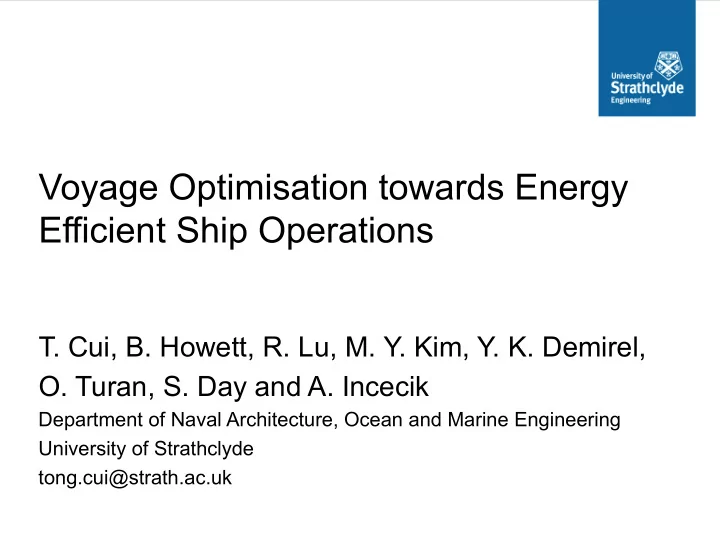

Voyage Optimisation towards Energy Efficient Ship Operations T. Cui, B. Howett, R. Lu, M. Y. Kim, Y. K. Demirel, O. Turan, S. Day and A. Incecik Department of Naval Architecture, Ocean and Marine Engineering University of Strathclyde tong.cui@strath.ac.uk
1. Introduction • Almost 90% goods traded worldwide are transported by sea • Ship performance prediction • Grids system design • Weather routing ETA and Fuel consumption • Voyage optimisation Post processing •
2. Voyage Optimisation Model 2.1. Ship performance predic2on Ship Performance Profile File (netCDF from WSM, WASPP…) “This file is to package performance related aFributes of an individual ship for a whole range of environmental and opera2onal condi2ons in a single file, allowing data to be pre-calculated for later use in 2me intensive applica2ons”( HoweF, B., 2015). • Speed • Significant wave height 5-D Interpolation • Relative wave angle Brake power • True wind speed Relative wind angle • = ⋅ ⋅ FC P sfoc t B
2.2. Grids system design module 2.2.1 Main design principles Grids system Ship rou0ng network
2.2.2 Land avoidance func2on GSHHS (A Global Self-consistent, Hierarchical, High-resolu2on Shorelines Geography Database) coastline data
2.3. Weather rou2ng module 2.3.1 Weather data GRIB: waves and winds downloaded from ECMWF (European Centre for Medium-Range Weather ) • 10 meter U wind component • 10 meter V wind component • Mean wave direction • Mean wave period significant height of combined wind waves and swell • 36 years (1979-2014) global historic weather data is downloaded for the shipping simulation.
2.3.2 Weather rou2ng module Local Op0misa0on Global Op0misa0on
2.4 Post processing module • Stage 1 FC ETA FC Dura2on Speed La2tude Longitude • • • total total last stage last stage last stage last stage last stage 1 FC_T_1 ETA_T_1 FC_L_1 T_L_1 V_L_1 Lat_L_1 Lon_L_1 • • • • • 2 FC_T_2 ETA_T_2 FC_L_2 T_L_2 V_L_2 Lat_L_2 Lon_L_2 3 FC_T_3 ETA_T_3 FC_L_3 T_L_3 V_L_3 Lat_L_3 Lon_L_3 4 FC_T_4 ETA_T_4 FC_L_4 T_L_4 V_L_4 Lat_L_4 Lon_L_4 5 FC_T_5 ETA_T_5 FC_L_5 T_L_5 V_L_5 Lat_L_5 Lon_L_5 … Stage K • FC ETA FC Dura2on Speed La2tude Longitude total total last stage last stage last stage last stage last stage 1 FC_T_1 ETA_T_1 FC_L_1 T_L_1 V_L_1 Lat_L_1 Lon_L_1 2 FC_T_2 ETA_T_2 FC_L_2 T_L_2 V_L_2 Lat_L_2 Lon_L_2 Backward Itera0on Algorithm 3 FC_T_3 ETA_T_3 FC_L_3 T_L_3 V_L_3 Lat_L_3 Lon_L_3 4 FC_T_4 ETA_T_4 FC_L_4 T_L_4 V_L_4 Lat_L_4 Lon_L_4 5 FC_T_5 ETA_T_5 FC_L_5 T_L_5 V_L_5 Lat_L_5 Lon_L_5 …
3. Case Study and Discussion Ship model: Bulk Carrier. Departure and destination points: 5°10‘W, 49°18’N and 70°31‘W, 40°48'N. Departure time: 2014-01-05, 06:00. Ship speed: 4 knots to 20 knots with interval 0.1 knot. ETA: 227 hours (average 12 knots). Interest ETA range: 6 hours (within plus or minus 3 hours). Grids system has 14 stages, and every stage has maximum 15 waypoints with equal distance of 50 nautical miles.
Three days’ significant wave height changing from departure 2me a) 06:00 05/01/2014 b) 06:00 06/01/2014 c) 06:00 07/01/2014
Results 146 145.34 tonnes � 144 Fuel consump0on (tonne) 142 4.5% more � 140 139.01 tonnes � 138 3.1% less � 136 134.78 tonnes � 134 224 225 226 227 228 229 230 ETA (hour) Pareto front of case study
14 13.8 224 Hours Route 227 Hours Route 230 Hours Route 13.6 13.4 13.2 Speed (knots) 13 12.8 12.6 12.4 12.2 12 11.8 11.6 18 11.4 224 Hours Route 227 Hours Route 230 Hours Route 1 2 3 4 5 6 7 8 9 10 11 12 13 14 15 17.5 Stage 17 Dura0on (hours) a) Ship speed at each stage 16.5 16 15.5 14.5 15 14 224 Hours Route 227 Hours Route 230 Hours Route Fuel consump0on (tonne) 14.5 13.5 13 14 12.5 1 2 3 4 5 6 7 8 9 10 11 12 13 14 15 12 Stage 11.5 11 b) Dura0on at each stage 10.5 10 9.5 9 8.5 1 2 3 4 5 6 7 8 9 10 11 12 13 14 15 Stage c) Fuel consump0on at each stage
14 12 224 Hours Route 227 Hours Route 13.8 230 Hours Route wave height of 224 Hours Route 13.6 10 13.4 Wave Height (m) 13.2 8 Speed (knots) 13 12.8 6 12.6 12.4 4 12.2 12 2 11.8 11.6 11.4 0 1 2 3 4 5 6 7 8 9 10 11 12 13 14 15 Stage Speed changing with wave height
Op0mal routes based on different requirements
4. Conclusion This paper presents a voyage op2misa2on model towards Energy Efficient Ship Opera2ons : • The core modules and op2misa2on strategy used in this model are introduced in great detail. • A case study with Bulk Carrier has been made. • As can be seen from results, with the strategy of a combina2on of global and local op2misa2on, this model can provide related stakeholders op2mum routes towards minimum fuel consump2on according to the ship naviga2on schedule.
Recommend
More recommend